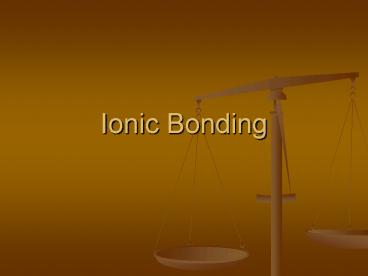Ionic Bonding - PowerPoint PPT Presentation
Title:
Ionic Bonding
Description:
Ionic Bonding Stable Electron Configurations When the highest occupied energy level of an atom is filled with electrons, the atom is stable and not likely to react. – PowerPoint PPT presentation
Number of Views:61
Avg rating:3.0/5.0
Title: Ionic Bonding
1
Ionic Bonding
2
Stable Electron Configurations
- When the highest occupied energy level of an atom
is filled with electrons, the atom is stable and
not likely to react. - The chemical properties of an element depend on
the number of valence electrons.
3
Electron Dot Diagram
- An electron dot diagram is a model of an atom in
which each dot represents a valence electron
(lewis dot structure). - The symbol in the center represents the nucleus
and all the other electrons in the atom.
4
Ionic Bonds
- Elements that do not have complete sets of
valence electrons tend to react. - Some elements achieve stable electron
configurations through the transfer of electrons
between atoms.
5
Transfer of Electrons
- If a chlorine atom were to gain a valence
electron, it would become stable. - If a sodium atom were to lose an electron its
highest occupied energy level would have eight
electrons. - If sodium reacts with chlorine and electron is
transferred from each sodium atom to a chlorine
atom. Each atom ends up with a more stable
electron arrangement that it had before the
transfer.
6
Formation of Ions
- When an atom gains or loses an electron, the
number of protons is no longer equal to the
number of electrons. - The charge on the atom is not balanced and the
atom is not neutral. - An atom that has a net positive or negative
electric charge is called an ion.
7
Ions
- The charge on an ion is represented by a plus or
a minus sign. - An ion with a negative charge is an anion.
- Anions are named by using part of the element
name plus the suffix ide. - EX Cl- is called a chloride ion.
8
Ions
- An ion with a positive charge is a cation.
- To name a cation you use the element name
- Na is called a sodium ion.
9
Formation of Ionic Bonds
- A particle with a negative charge will attract a
particle with a positive charge. - When an anion and a cation are close together, a
chemical bond forms between them.
10
Formation of Ionic Bonds
- A chemical bond is the force that holds atoms or
ions together as a unit. - An ionic bond is the force that holds cations and
anions together. - An ionic bond forms when electrons are
transferred from one atom to another.
11
Ionization Energy
- An electron can move to a higher energy level
when at atom absorbs energy. - Cations form when electrons gain enough energy to
escape from atoms. - The energy allows electrons to overcome the
attraction of the protons in the nucleus.
12
Ionization Energy
- The amount of energy used to remove an electron
is called ionization energy. - It varies from element to element. The lower the
ionization energy, the easier it is to remove an
electron from an atom.
13
Ionization Energy
- Ionization energies tend to increase from left to
right across a period and decrease from the top
of a group to the bottom. - It takes more energy to remove an electron from a
nonmetal than from a metal in the same period.































